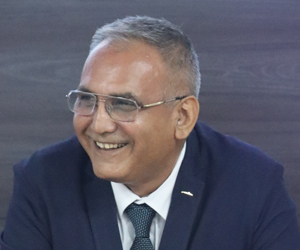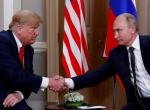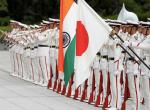Over the past 1,000 days, the world has crossed an invisible yet critical threshold in the domain of mutually assured security. While the previous system was far from perfect, it maintained a relative balance and stability. Today, however, we find ourselves in uncharted territory, where the concept of shared security between Russia, the United States, the European Union, and their respective allies has fractured. This breach has unleashed a cascade of unpredictability, fuelled by escalating rhetoric in both public discourse and media, deepening the ideological and political trenches on either side of this divide.
The Arctic has not been spared from this division. Its principal governing body, the Arctic Council, failed its first significant stress test, pushing the region closer to instability by isolating Russia and assuming that major regional challenges could be resolved without its involvement. The situation was further exacerbated by Finland and Sweden's entry into NATO, which ended their previous posture of neutrality amid the escalating Ukrainian crisis. As a result, the Arctic Council lost its ability to act as a neutral platform, devolving into a classic "Us vs. Them" dynamic.
Within this "divided Arctic home," NATO-aligned nations often appear to lack a cohesive Arctic strategy beyond vague aspirations of promoting good and opposing bad.[1] On the other hand, Russia has amended its Arctic strategy prioritising bilateral engagement over Arctic Council.[2] This divergence underscores the growing fragmentation in a region once viewed as a model for international cooperation.
An assessment of Russia’s Arctic interests and intentions, as outlined in various strategic documents, can be summarised into the following key pillars:
The Arctic as a Critical Interest Area of Russia
The Arctic and Arctic Ocean are central to Russia's strategic interests, the stated goals encompassing utilisation of its natural resources, protection of its ecosystems, using the seas as a transportation system, and ensuring that it remains a zone of peace and cooperation.
Concurrently, the energy sector’s growth is increasingly tied to advancements in reducing carbon footprints and greenhouse gas emissions. Achieving this necessitates the integration of alternative energy sources such as solar, wind, and thermal systems. These advancements are critical for meeting rising regulatory and social expectations regarding climate change and ecological sustainability.
Infrastructure development is another pressing challenge in the Arctic. The current "extract and export" model limits the full realisation of the Arctic’s energy potential. Diversifying into renewable energy could help meet global demands for localised energy solutions, particularly in remote and challenging territories such as the Arctic. While Russia has, especially after the launch of its special military operations in Ukraine, pursued this goal independently, the growing need for such solutions necessitate deeper energy cooperation with other countries. In the status of Russia’s current isolation, this provides China with an opportunity to deepen its engagement and enhance its footprint in the Arctic
Adherence to International Agreements and Sovereignty
Russia possibly remains committed to upholding international agreements, even those it has not formally ratified, as long as they do not challenge its sovereignty over the Northern Sea Route (NSR) and its Arctic zone. Key examples include delimitation and demarcation agreements with the USA, such as the Shevarnadze-Baker line, which, though not ratified by the State Duma, continues to be adhered by Russia despite the escalating rhetoric.[3] Examples such as Russia’s continuation in the Arctic Council, despite the cessation of all work in the council, signal Russia’s hopes for an eventual resumption of circumpolar cooperation. The recent termination of the fishing agreement with the UK in the Barents Sea was possibly in retaliation to the UK ending its most favoured nation clause in its bilateral trade agreement with Russia, in March 2022.
Military and Strategic Defence in High Latitudes
Russia views its defensive capabilities in the Arctic as non-negotiable. Historically, the western sector of its Arctic zone and the North Atlantic have been focal points for NATO’s military deterrence efforts, driven by the Russian Northern Fleet's operations. These have got exacerbated by the NATO membership of Finland and Sweden[4] and USA signing Defence Cooperation Agreement with Finland, Sweden and Denmark which will provide US Armed Forces unrestricted access to the military infrastructure (air, sea and land bases) of these countries: 17 locations in Sweden, 15 in Finland and three in Denmark.[5] This will practically encircle the Kola peninsula where the bult of the Russian second-strike capability is based.
In recent years, there has been a notable increase in U.S. and Canadian military activities near Russia's eastern Arctic zone. Russia’s current anti-access/area-denial (A2AD) capabilities in this region prioritise securing the NSR and protecting potential oil and gas reserves rather than countering conventional naval threats.
As tensions rise, collaboration between the Russian and Chinese fleets is evolving. While presently situational, this partnership may deepen, driven by shared interests in projecting power in Arctic waters and ensuring regional security.
Russia’s Role in the Arctic
Russia's special status in the Arctic is underpinned by its historical ties, economic presence, and level of regional development. Russia’s plans to expand its military and economic footprint in the Arctic persist, even in the face of challenges such as shifting project timelines, limited access to certain technologies, budget reallocations, and increased NATO activity in the Barents-Baltic region. The European Union’s growing scrutiny of Arctic mining and energy projects, particularly in Russian territories, adds another layer of complexity. Nonetheless, Russia continues to prioritise its long-term Arctic ambitions, adapting to evolving circumstances while advancing its strategic goals.
Present Situation in the Arctic
For meaningful and conciliatory interaction in the Arctic to become feasible, the West has to consider that Russia’s foundational Arctic policy pillars are non-negotiable—at least for the medium-term horizon of 15–20 years. Ignoring or undermining these principles would inevitably escalate tensions. A rigid stance offers little opportunity to Russia for building "bridges" with the West, which appears committed to containing Russia by any means, despite its limited expertise and resources in Arctic operations (e.g., the number of operational icebreakers, though Finland's integration into NATO could mitigate this gap).
The challenge is compounded by a broader rift in Russia-West relations. Dialogue is frequently dominated by the "Ukrainification" of every issue, with disputes refracted through a singular lens that prevents constructive engagement. This dynamic extends to Arctic strategising, making it exceedingly difficult to navigate out of the current conflict and avoid erecting new barriers.
Nevertheless, certain areas could potentially serve as starting points for rebuilding cooperation, with scientific collaboration being a clear frontrunner. However, confining cooperation solely to science risks marginalising Russian interests. For instance, the resumption of scientific exchanges within the Arctic Council, celebrated by some as a “win-win,” is superficial. Reduced to minimal, email-based communication framed by Western priorities, it seems more like a symbolic gesture than a genuine return to normalcy.
The Arctic's role as a global "weather kitchen"[6] further complicates matters. Historically, its meteorological significance has been tied to both peace and war. During WWII, the region was crucial for both Axis and Allied meteorologists, who sought to establish observation stations for better forecasting in the Atlantic and Pacific theaters. Presently, with trust between Russia and the West at historic lows, there is an apprehension in Russia that data shared by Russian researchers will not be used exclusively for peaceful purposes.
It is clear that attempts to reconfigure the global system of checks and balances developed over the past 30 years are impacting every region, including the Arctic. In recent years, parallel and often redundant systems for managing the Arctic agenda have emerged, such as the Arctic Circle and Nordic Plus forums. Russia's participation in these platforms has often been overshadowed by other nations, as they work to establish a new Western-centric narrative for the Arctic. This narrative emphasises control over transport routes, biological resources, mineral wealth, and regional security—often in collaboration with entities like the European Union and NATO. The overarching goal appears to be the containment of Russia and the restriction of its activities in the high latitudes, signaling a significant geopolitical shift in the region.
Environmental protection issues, which hold particular importance in the Arctic, are increasingly being weaponised as tools of economic warfare. Examples of this include bans on International Maritime Organisation (IMO)-compliant fuels, the refusal of major shipping companies and light industry stakeholders to utilise the Northern Sea Route (NSR), and efforts to ban or severely limit Arctic oil and gas production. These measures, widely reported in the media, reflect a growing trend toward leveraging environmental concerns for geopolitical and economic gain.
To mitigate tensions and foster stability, it is essential to establish a robust communication channel for addressing regional security concerns. This mechanism should include representatives from all Arctic nations and other stakeholders with vested interests in the region, extending beyond Western countries. In this context, and its present isolation in the Arctic Council and other Arctic forums, Russia has several options for shaping alternative governance frameworks for the Arctic:
Isolationist Approach
With the world’s longest Arctic coastline and the largest fleet of icebreakers, Russia is well-positioned to independently implement military and commercial projects in its Arctic zone. This approach allows for the creation of a self-defined agenda free from external influence. However, it risks attracting criticism from both Western and Asian nations, potentially driving these groups closer together based on shared interests in Arctic development.
Adversarial Approach
Russia could leverage its BRICS+ partnerships to establish a counterbalance to the Arctic Council or other Western-led forums. This strategy aligns with the aspirations of certain BRICS+ members, who are keen to expand their research, commercial, and military activities in the Arctic. However, this approach carries risks, particularly the potential for intra-group conflicts driven by diverging views on Arctic governance. For instance, China’s and India’s perspectives on Arctic policies differ significantly from Russia’s, complicating cohesive action.
China’s foreign policy, marked by consistency and autonomy, positions it as a major advocate for BRICS+ expansion, using these structures to further its Arctic ambitions. Conversely, India, despite its neutrality, seemingly leans toward the United States, particularly as a counterbalance to China’s influence. While India has shown interest in Arctic affairs, its lack of resources limits its ability to sustain a meaningful presence in the region. Meanwhile, the U.S. views India as a strategic partner to offset China’s growing Arctic footprint, reflecting the disparity between U.S. rhetoric and actual capabilities in the polar regions.
Reformist Approach
A reformist strategy seeks to revise existing Arctic governance structures while minimising conflict. By framing the Arctic as a shared global asset, this approach resonates with many international actors, particularly those advocating for increased representation of the Global South in Arctic affairs. Such reforms could address long-standing disparities in participation and influence, fostering a more inclusive governance model.
Integrationist Approach
Building on the reformist perspective, an integrationist strategy emphasises the Arctic’s unique and complex nature, requiring collaborative efforts for scientific exploration and commercial development. This approach envisions creating a platform independent of China, India, or the BRICS bloc, instead engaging regional and subregional alliances, scientific and business communities, the Commonwealth of Independent States (CIS), and influential global figures.
Incorporating not only countries and organisations but also individuals, enables the use of informal channels—scientific, business, and “people’s diplomacy.” Establishing and maintaining these informal networks becomes vital in light of certain countries’ withdrawal from existing platforms.
What Can India Do?
India and Russia share a longstanding and multifaceted relationship. Their strategic partnership has grown through high-level cooperation in areas like defence, energy, nuclear, space, and technology. India values this relationship, and Russia reciprocates, as seen in President Putin's support for India's independent foreign policy. With Russia potentially facing isolation in the Arctic Council, closer ties with India are likely, given India’s growing geopolitical importance. India should enhance its Arctic engagement to protect national interests, particularly in energy security and access to rare earth minerals, as evidenced by India's significant oil imports from Russia. Strengthening bilateral cooperation in the Arctic, and supporting Russia's BRICS+ proposal, could reduce Russia's reliance on China and open new opportunities for Indian industries.
Way Forward
Building "bridges" in the Arctic is not only possible but necessary for Russia. Adopting an isolationist stance would limit Russia’s ability to engage with interested nations while inadvertently enhancing its dependence on China. By pursuing alternative governance mechanisms, fostering inclusivity, and leveraging informal diplomacy, Russia can retain its influence in Arctic affairs while mitigating the risks of geopolitical isolation.
References
[1] Markus J. Thongauen ‘Why NATO Isn't as Powerful as We Imagine’, NORD University, 2024-10-16 https://www.nord.no/en/news/why-nato-isnt-as-powerful-as-we-imagine
[2] Decree of the President of the Russian Federation of March 5, 2020 N 164 "On the Fundamentals of the State Policy of the Russian Federation in the Arctic for the Period up to 2035"
[3] Boris Tkachenko ‘Territorial and border dispute between Russia and the United States in the Arctic and the Bering Sea’, Russia and APR, 2017 http://www.riatr.ru/2017/2/Russia_and_ATR_2017-2_084-096.pdf
[4] NATO Enlargement to Sweden and Finland https://crsreports.congress.gov/product/pdf/IN/IN11949
[5] Jacek Tarociński, Finland, Sweden and Denmark: Defence Cooperation Agreements with the USA, Analyses, 2023-12-27 https://www.osw.waw.pl/en/publikacje/analyses/2023-12-27/finland-sweden-and-denmark-defence-cooperation-agreements-usa
[6] The Arctic – The ‘Weather Kitchen’ https://forumarctica.ru/en/news/arktika-%C2%ABkuhnja%C2%BB-pogody/
(The paper is the author’s individual scholastic articulation. The author certifies that the article/paper is original in content, unpublished and it has not been submitted for publication/web upload elsewhere, and that the facts and figures quoted are duly referenced, as needed, and are believed to be correct). (The paper does not necessarily represent the organisational stance... More >>
Image Source: https://images.prismic.io/arctic-circle-www/Zs9A80aF0TcGJe1e_Untitleddesign-16-.png?auto=format,compress












Post new comment